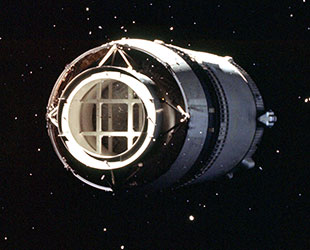 advertisements advertisements
|

|
Coverage: Saturn V stage sighted in space
Paint sheds light on object's identity
September 18, 2002 — Astronomers at the Lunar and Planetary Laboratory at the University of Arizona say they have the first direct evidence that object J002E3 is a spent stage from one of the Apollo Saturn V launches.
Carl Hergenrother and Robert Whiteley used the Steward Observatory in the Santa Catalina Mountains to measure reflected light from J002E3. Their findings revealed the object spins once every 63.5 seconds or once every 127 seconds — more observations are needed to pin down the exact time.
"Such a rapid rate of rotation is not unheard of either for an asteroid or a piece of man-made space junk, but is very consistent with each," said Hergenrother.
Hergenrother and Whiteley then applied filters to sample the spectra, or colors, that J002E3 reflects.
"Rather than looking like a known asteroid, the colors were consistent with the spectral properties of an object covered with white titanium oxide paint," Hergenrother said. "The Apollo Saturn S-IVB upper stages were painted with TiO paint," he noted.
Observations conducted at the Massachusetts Institute of Technology (MIT) further confirmed the UA astronomers research. Infrared spectra "confirm that J002E3 is a dead ringer for white TiO paint," Hergenrother added.
As a result, the UA astronomers concluded that object J002E3 is most likely a S-IVB stage from either Apollo 8, 10, 11, or 12, with Apollo 12 being most likely.
Newfound satellite may be Saturn stage
by Paul Chodas, NASA/JPL Near-Earth Object Program

Photograph taken from the Apollo 8 spacecraft looking back at the Saturn V third (S-IVB) stage from which the spacecraft had just separated following translunar injection. (NASA) |
September 12, 2002 — An analysis of the orbital motion of the newly discovered object J002E3 indicates that it could be a leftover Saturn V third stage from one of the Apollo missions, most likely the Apollo 12 mission, launched on November 14, 1969.
The new object was discovered on September 3 by Bill Yeung, who noted that it was moving quite rapidly. Initial orbit computations by the Minor Planet Center indicated that the object was only about twice as far away as the Moon, and was actually in orbit about our planet. This fact, combined with the rather faint intrinsic magnitude, immediately led astronomers to suspect that the object is actually a spacecraft or rocket body, not an asteroid. But the object could not be associated with any recent launch.
J002E3 is currently observable at magnitude 16.5; it is easily detectable in asteroid surveys, and even bright enough to be seen by many amateur astronomers. If it is a leftover piece from an old launch, why was it not discovered until last week? A backwards analysis of the orbital motion provides the answer: the object was apparently captured by the Earth from heliocentric orbit in April of this year.
The capture occurred when the object passed near the Earth's L1 Lagrange point, a location where the gravity of the Earth and Sun approximately cancel. This point serves as "portal" between the regions of space controlled by the Earth and Sun. J002E3 is the first known case of an object being captured by the Earth, although Jupiter has been known to capture comets via the same mechanism. (For example, Comet Shoemaker-Levy 9, which collided with Jupiter in 1994, had been captured by Jupiter decades earlier.)
Analysis of J002E3's pre-capture orbit about the Sun shows that the object was always inside the Earth's orbit, and that it may have come within the Earth's vicinity in the early 1970s or late 1960s. Many of the test cases in our analysis in fact passed through the L1 portal, back into Earth orbit (going backwards in time) during the early 1970s.
In other words, this object was very likely orbiting the Earth during this period before escaping into the heliocentric orbit from which it was captured in 2002. It seems quite likely that this object is one of the Apollo Saturn S-IVB third stages which flew by the Moon during this era (Apollos 8 through 12). The brightness of J002E3 seems to match the expected brightness of an S-IVB stage.
Further circumstantial evidence suggests that this object is in fact the Apollo 12 stage, which was left in a very distant Earth orbit after it passed by the Moon on November 18, 1969. This spent rocket body was last seen in an Earth orbit with a period of 43 days, not much different from J002E3's current orbit.
The future motion of J002E3 is also very interesting. A similar orbital analysis which takes into account the current orbit uncertainties shows that the object has a surprisingly large 20 percent chance of impacting the Moon in 2003. Such a lunar impact would not be unprecedented: NASA intentionally impacted five Apollo S-IVB stages on the Moon from 1970 through 1972 (Apollos 13 through 17), as an experiment to study the interior structure of the Moon.
Looking further into the future is problematic, due to the chaotic nature of J002E3's orbit, but our current analysis shows the object to have about a 3 percent chance of impacting the Earth within the next 10 years. This should not be of concern to the public. Apollo stages have impacted the Earth before, in the 1960s, and the larger Skylab re-entered in the 1970s. (The even larger Mir Space Station was intentionally impacted into the Pacific Ocean in 2001.)
Additional positional observations of this object are being received daily, and our knowledge and modeling of its orbit continues to improve. The collision probabilities mentioned above will change as we are able to make more precise predictions. |

© 1999-2025 collectSPACE. All rights reserved.

|
|

|

|
